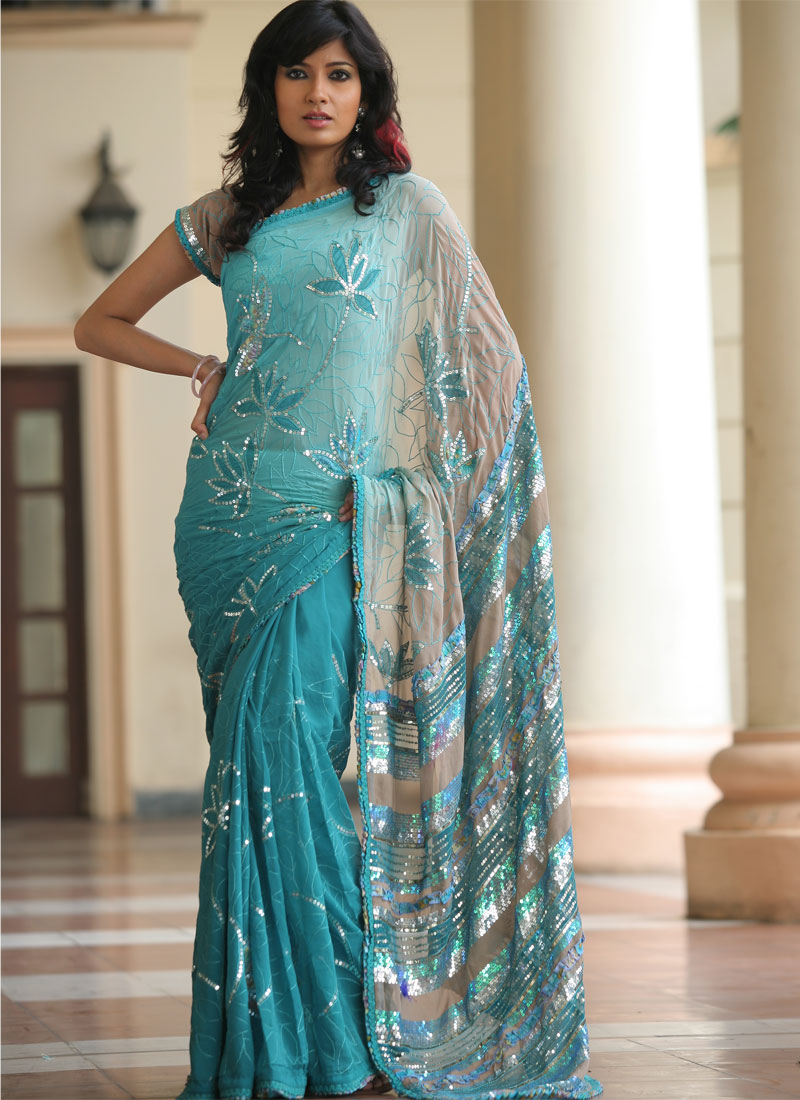Indian Sarees Biography
Sorce (Google.com.pk)A sari or saree is a strip of unstitched cloth, worn by women, ranging from four to nine yards in length that is draped over the body in various styles which is native to the Indian Subcontinent.The word sari is derived from Sanskrit शाटी śāṭī which means 'strip of cloth' and शाडी śāḍī or साडी sāḍī in Prakrit, and which was corrupted to sāṛī in Hindi.The word 'Sattika' is mentioned as describing women's attire in ancient India in Buddhist Jain literature called Jatakas. This could be equivalent to modern day 'Sari'. The term for female bodice, the choli is derived from another ruling clan from ancient Tamil nadu, the Cholas. Rajatarangini (meaning the 'river of kings'), a tenth-century literary work by Kalhana, states that the Choli from the Deccan was introduced under the royal order in Kashmir. The concept of Pallava, the end piece in the sari, originated during the Pallavas period and named after the Pallavas, another ruling clan of Ancient Tamilakam.
It is popular in India, Bangladesh, Pakistan, Nepal, Sri Lanka, Bhutan, Burma, Malaysia, and Singapore. The most common style is for the sari to be wrapped around the waist, with one end then draped over the shoulder, baring the midriff.
The sari is usually worn over a petticoat (called lahaṅgā or lehenga in the north; langa, pavada, or pavadai in the south; chaniyo, parkar, ghaghra, or ghagaro in the west; and shaya in eastern India), with a blouse known as a choli or ravika forming the upper garment. The blouse has short sleeves and a low neck and is usually cropped at the midriff, and as such is particularly well-suited for wear in the sultry South Asian summers. Cholis may be backless or of a halter neck style. These are usually more dressy, with plenty of embellishments such as mirrors or embroidery, and may be worn on special occasions. Women in the armed forces, when wearing a sari uniform, don a short-sleeved shirt tucked in at the waist. The sari developed as a garment of its own in both South and North India at around the same time, and is in popular culture an epitome of Indian culture.The sari signified the grace of Indian women adequately displaying the curves at the right places.It is generally accepted that wrapped sari-like garments for lower body and sometimes shawls or scarf like garment called 'uttariya' for upper body, have been worn by Indian women for a long time, and that they have been worn in their current form for hundreds of years. In ancient couture the lower garment was called 'nivi' or 'nivi bandha', while the upper body was mostly left bare. The works of Kalidasa mentions 'Kurpasika' a form of tight fitting breast band that simply covered the breasts. It was also sometimes referred to as 'Uttarasanga' or 'Stanapatta'.The tightly fitted, short blouse worn under a sari is a choli. Choli evolved as a form of clothing in the 10th century AD, and the first cholis were only front covering; the back was always bare but covered with end of saris pallu. Bodices of this type are still common in the state of Rajasthan.
In South India and especially in Kerala, women from most communities wore only the sari and exposed the upper part of the body till the middle of the 20th century. Poetic references from works like Silappadikaram indicate that during the Sangam period in ancient Tamil Nadu, a single piece of clothing served as both lower garment and head covering, leaving the midriff completely uncovered. Similar styles of the sari are recorded paintings by Raja Ravi Varma in Kerala. By the mid 19th century, though, bare breasted styles of the sari faced social revaluation and led to the Upper cloth controversy in the princely state of Travancore (now part of the state of Kerala) and the styles declined rapidly within the next half a century.
Indian Sarees For Men Design For Men Designs For Women For Girls For Boys Images Photos Pictures

Indian Sarees For Men Design For Men Designs For Women For Girls For Boys Images Photos Pictures

Indian Sarees For Men Design For Men Designs For Women For Girls For Boys Images Photos Pictures

Indian Sarees For Men Design For Men Designs For Women For Girls For Boys Images Photos Pictures

Indian Sarees For Men Design For Men Designs For Women For Girls For Boys Images Photos Pictures

Indian Sarees For Men Design For Men Designs For Women For Girls For Boys Images Photos Pictures

Indian Sarees For Men Design For Men Designs For Women For Girls For Boys Images Photos Pictures

Indian Sarees For Men Design For Men Designs For Women For Girls For Boys Images Photos Pictures

Indian Sarees For Men Design For Men Designs For Women For Girls For Boys Images Photos Pictures

Indian Sarees For Men Design For Men Designs For Women For Girls For Boys Images Photos Pictures

Indian Sarees For Men Design For Men Designs For Women For Girls For Boys Images Photos Pictures

Indian Sarees For Men Design For Men Designs For Women For Girls For Boys Images Photos Pictures

Indian Sarees For Men Design For Men Designs For Women For Girls For Boys Images Photos Pictures

Indian Sarees For Men Design For Men Designs For Women For Girls For Boys Images Photos Pictures

No comments:
Post a Comment